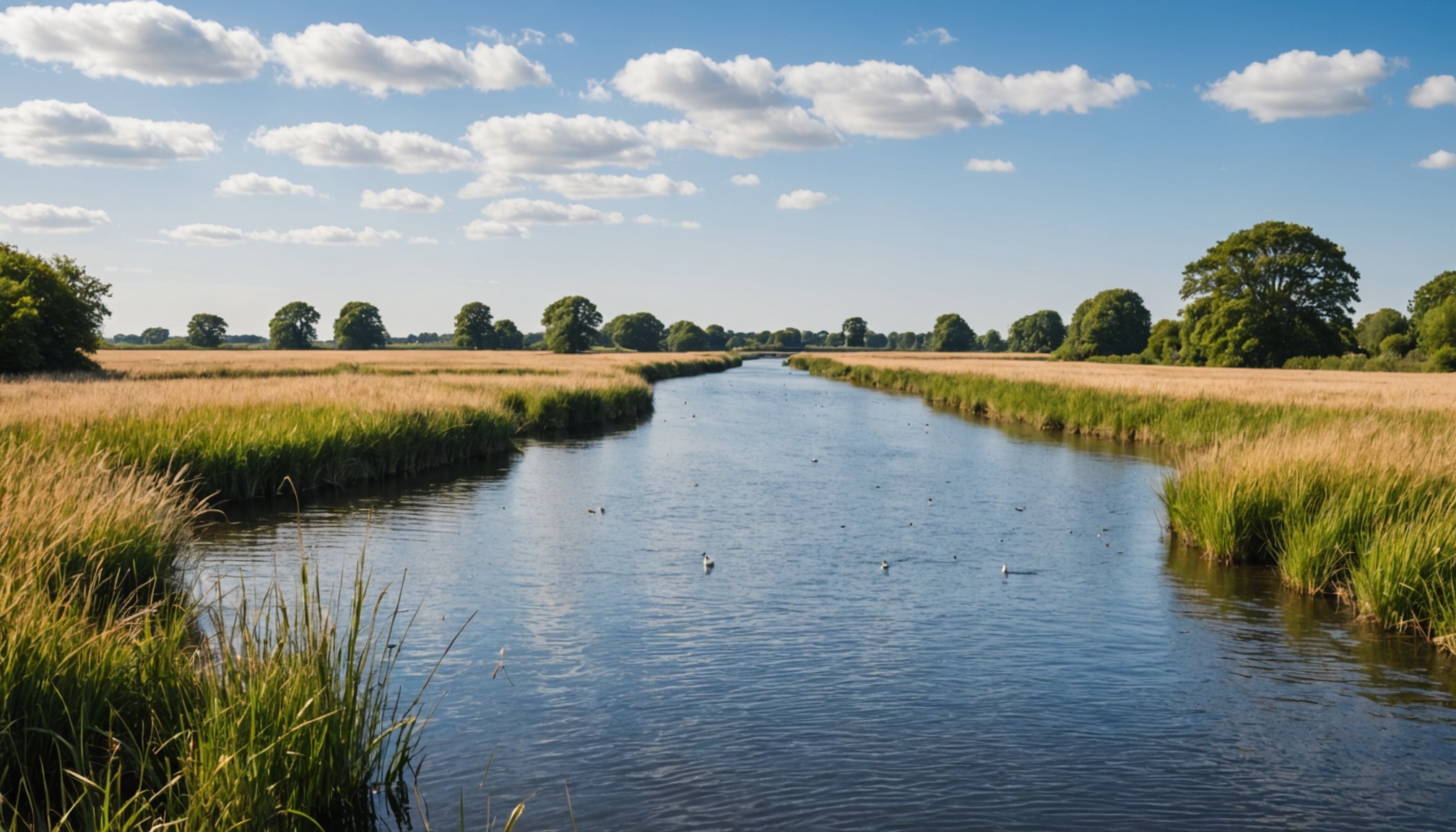Discovering the Top Birdwatching Hotspots in Norfolk Broads National Park
If you’re an avid birdwatcher or simply someone who appreciates the beauty of nature, Norfolk Broads National Park is a paradise you shouldn’t miss. Located in the heart of East Anglia, this park is renowned for its diverse and vibrant wildlife, particularly its avian inhabitants. Here’s a comprehensive guide to the best birdwatching hotspots within this stunning national park.
Understanding the Norfolk Broads National Park
Before diving into the specific hotspots, it’s essential to understand the broader context of the Norfolk Broads National Park. This park is a unique mosaic of 124 miles of navigable waterways and protected wetlands, making it a haven for a quarter of Britain’s rarest wildlife species[3].
In parallel : Seamless airport transfers: explore taxi services in liège
The Broads are not just a natural wonder but also a man-made landscape, shaped over centuries by human activities such as peat digging and flooding. This blend of natural and human influence has created a rich tapestry of habitats, including marshes, wetlands, and woodlands, which are perfect for birdwatching.
Top Birdwatching Hotspots
Titchwell Marsh RSPB Reserve
One of the most celebrated birdwatching sites in Norfolk is the Titchwell Marsh RSPB Reserve. Located on the north Norfolk coast, this reserve is a must-visit for any serious bird enthusiast. The reserve boasts six hides, including the Island Hide, which offers panoramic views of the marshes and the sea.
This might interest you : Top Destinations to Discover the Rich History of the British Railway System
- Species to Spot: Marsh harriers, bearded tits, avocets, and a variety of wading birds.
- Facilities: Well-maintained boardwalks, accessible hides, and an award-winning visitor centre with interactive exhibitions and a gift shop[2][5].
Holkham NNR–Lady Anne’s Drive and The Lookout
Holkham National Nature Reserve is another gem in the Norfolk Broads. The area around Lady Anne’s Drive and The Lookout is particularly notable for its diverse habitats, including salt marsh, mudflats, and dunes.
- Species to Spot: Common and grey seals, terns, and a wide range of migratory birds.
- Facilities: Panoramic views from the lookout, accessible boardwalks, and guided tours available[2][5].
Hickling Broad NNR–Hickling Marshes NWT NR, Brendan’s Marsh
Hickling Broad is one of the largest and most biodiverse broads in the Norfolk Broads National Park. This site is managed by both the National Trust and the Norfolk Wildlife Trust.
- Species to Spot: Bitterns, marsh harriers, and a variety of waterfowl.
- Facilities: Several hides, including the Brendan’s Marsh hide, and well-maintained walking trails[2][5].
Snettisham RSPB Reserve
Snettisham RSPB Reserve is famous for its ‘whirling wader spectacle’, where tens of thousands of wading birds take flight as the incoming tide pushes them off the vast mudflats.
- Species to Spot: Wading birds such as knot, dunlin, and bar-tailed godwit.
- Facilities: Panoramic views from the hides, guided tours, and a visitor centre with detailed information on the best viewing times[2][5].
Holme Dunes NWT NR and NNR
Located at the northwest corner of Norfolk, Holme Dunes is a key stopover for migratory birds. The site includes a four-mile shingle ridge and dune, backed by salt marsh and mudflats.
- Species to Spot: Common and grey seals, terns, and a variety of migratory birds.
- Facilities: Accessible boardwalks, hides, and guided tours available[2][5].
Other Notable Sites
Strumpshaw Fen RSPB Reserve
Strumpshaw Fen is a hidden gem within the Norfolk Broads. This reserve is known for its reedbeds and grazing marshes, home to kingfishers, otters, and water voles.
- Species to Spot: Kingfishers, otters, and marsh harriers.
- Facilities: Several hides, accessible boardwalks, and guided tours available[2].
Ranworth Broad
Ranworth Broad is a smaller but equally rewarding site for birdwatchers. It is part of the Norfolk Broads and offers a serene and peaceful environment.
- Species to Spot: Herons, geese, and cormorants.
- Facilities: Accessible walking trails and a visitor centre with local information[4].
Practical Tips for Birdwatching in Norfolk Broads
Best Times to Visit
The best time to visit Norfolk Broads for birdwatching depends on the species you are interested in. Here are some general guidelines:
- Winter: Ideal for spotting wintering birds such as geese, ducks, and waders. The ‘whirling wader spectacle’ at Snettisham RSPB Reserve is a highlight during this season[2].
- Spring and Autumn: These seasons are perfect for seeing migratory birds. Holme Dunes and Titchwell Marsh are particularly good during these times[2].
- Summer: This is the best time to see breeding birds such as marsh harriers and bearded tits[2].
Essential Gear
Here are some essentials to pack for a successful birdwatching trip:
- Binoculars: A good pair of binoculars is crucial for spotting birds at a distance.
- Field Guide: A comprehensive field guide to help you identify the species you see.
- Spotting Scope: Useful for getting a closer look at birds without disturbing them.
- Comfortable Footwear: Good walking shoes or boots are essential for navigating the trails and hides.
- Weather Gear: Norfolk weather can be unpredictable, so bring layers and waterproof gear[2].
Community and Resources
eBird and Local Birding Communities
eBird is a valuable resource for birdwatchers, providing real-time data on bird sightings and hotspots. The Norfolk eBird page is updated regularly and offers insights into the latest sightings and trends[1].
Local birding communities and clubs are also a great way to connect with other enthusiasts, get tips on the best spots, and participate in guided tours.
Visitor Centres and Guides
Each of the major reserves within the Norfolk Broads has a well-equipped visitor centre. These centres offer interactive exhibitions, guided tours, and expert advice on the best times and places to spot specific species.
For example, the Titchwell Marsh RSPB Reserve visitor centre is renowned for its interactive interpretation and regularly changing exhibitions. The staff are knowledgeable and can provide valuable insights into the local wildlife[2].
Table: Comparison of Top Birdwatching Hotspots
| Location | Key Species | Facilities | Best Time to Visit |
|---|---|---|---|
| Titchwell Marsh RSPB Reserve | Marsh harriers, bearded tits, avocets | Six hides, accessible boardwalks, award-winning visitor centre | Spring, Autumn, Winter |
| Holkham NNR–Lady Anne’s Drive | Common and grey seals, terns | Panoramic views, accessible boardwalks, guided tours | Winter, Summer |
| Hickling Broad NNR–Hickling Marshes | Bitterns, marsh harriers, waterfowl | Several hides, well-maintained walking trails | Spring, Autumn |
| Snettisham RSPB Reserve | Wading birds such as knot, dunlin, bar-tailed godwit | Panoramic views from hides, guided tours | Winter |
| Holme Dunes NWT NR and NNR | Common and grey seals, terns, migratory birds | Accessible boardwalks, hides, guided tours | Spring, Autumn |
Quotes from Birdwatchers
- “The ‘whirling wader spectacle’ at Snettisham RSPB Reserve is a sight to behold. It’s like nothing I’ve ever seen before,” says David Russell, a local birdwatcher.
- “Titchwell Marsh is my go-to spot for spotting marsh harriers and bearded tits. The hides are so well-maintained, and the staff are incredibly knowledgeable,” remarks Ashley Banwell, a frequent visitor to the reserve[1].
Norfolk Broads National Park is a birdwatcher’s paradise, offering a diverse range of habitats and species that are hard to find anywhere else. Whether you’re a seasoned enthusiast or just starting out, the park’s well-managed reserves, accessible facilities, and vibrant community make it an ideal destination for anyone passionate about birdwatching.
So pack your binoculars, grab your field guide, and head to Norfolk Broads. The birds are waiting, and the experience will be unforgettable.








